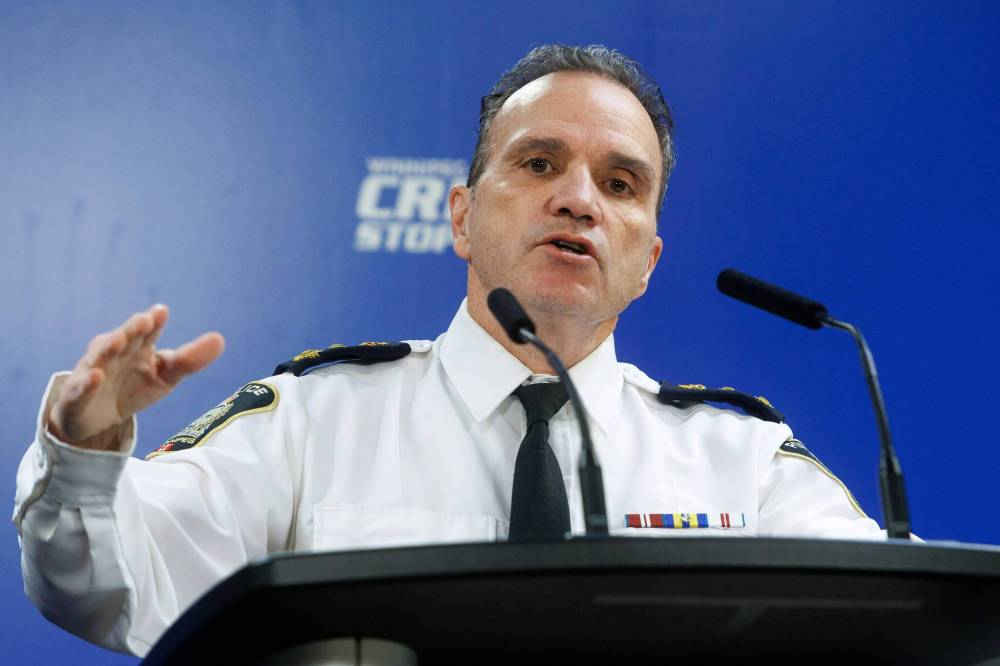
About six candidates have applied to become Winnipeg’s next police chief — a position vacated Tuesday as Danny Smyth retired after nearly eight years in the job.
Police board chair Coun. Markus Chambers told the Free Press he hopes the number of applicants rises to about a dozen prior to Friday’s deadline.
“We will start by screening down the list of applicants — depending on how many people apply — and then short-list candidates for interviews, likely in early October,” the councillor for St. Norbert-Seine River said.
MIKE DEAL / FREE PRESS FILES Winnipeg Police Chief Danny Smyth officially retired Tuesday after almost 40 years in policing. 
Chambers expects city council to vote in November on whether to hire a recommended candidate.
Smyth, whose career in policing spanned almost 40 years, is not doing exit interviews with the media, a spokeswoman said.
Art Stannard, a deputy chief with the Winnipeg Police Service since 2010, will serve as acting chief until Smyth’s replacement is hired.
Chambers said he doesn’t think Stannard is interested in applying.
The job, which was posted Aug. 8, is open to internal and external candidates. The city hired Meyers Norris Penny LLP to help recruit candidates as part of a nationwide search.
Chambers said about six people had applied when he last checked.
The next chief will be responsible for a public safety organization that has about 1,960 full-time equivalent positions and a budget of about $330 million, while serving a population of more than 845,000.
Winnipeg residents who participated in public consultations told the police board the chief must be a good collaborator who can work with Indigenous, newcomer and other communities, said Chambers.
The job posting said the successful candidate must ensure there is a culture of “accountability, transparency, inclusion, empowerment, high performance and continuous improvement.”
“The challenge, I guess, would be to align the service with the vision of the city in terms of community safety,” said Chambers.
The chief, who reports to the police board at city hall, will be paid as much as $313,643 per year.
Police Accountability Coalition co-chair Angelina Pelletier said it’s important the person has experience working with the community and knowledge of social justice issues.
The person should be a “relationship builder” who is responsive to community needs and voices, and can effectively balance their commitments to the WPS and community, she said.
“As a group, we’ve talked a lot about a change in culture and how that is needed, and how a strong leader will be able to effect that kind of change,” said Pelletier.
Last year, PAC decided to stop meeting with Smyth and his executive team. PAC members felt Smyth was not receptive, and the relationship was not moving in a positive direction, said Pelletier.
PAC has most notably advocated for non-emergent and non-violent mental health calls to be handled by crisis workers rather than police officers, following a number of recent police-involved shootings. Smyth opposed the calls.
Smyth announced his retirement in December. He recently completed a two-year term as president of the Canadian Association of Chiefs of Police.
Smyth received Chambers’s approval on his final day as chief.
“Chief Smyth has led the organization very well,” the councillor said.
Chambers said Smyth fulfilled his mandate to reduce police overtime, introduced specialized units which focus on violent or major crimes, led the service’s approach to missing and murdered Indigenous women, girls, two-spirit, transgender and gender-diverse people, and was the only police chief in Canada to provide testimony to the national MMIWG inquiry.
“These are really strong examples of his strong leadership,” said Chambers.
At the inquiry, Smyth apologized for the WPS’s treatment of Indigenous women and girls.
In 2022, Indigenous leaders called on Smyth to resign, after he announced the WPS would not search the Prairie Green Landfill for the remains of Morgan Harris and Marcedes Myran, who were slain by a serial killer.
Smyth said a search wasn’t feasible due, in part, to the volume of additional waste deposited and compacted in an area where the women’s remains are believed to be buried.
A search will go ahead due to the efforts of an Indigenous-led committee that conducted its own feasibility study, and $40 million in combined funding from the provincial NDP and federal Liberal governments.
Smyth had to steer the WPS through surges in calls for service and well-being checks, various crime trends including a spike in violent crime, and the impacts of the COVID-19 pandemic and the murder of George Floyd by a Minneapolis police officer, which prompted a “defund the police” movement across the U.S. and Canada.
A recent police board survey suggested a steady decline in confidence in Winnipeg police, down from 81 per cent in 2015 to 58 per cent in 2024.
At his final police board meeting in June, Smyth lobbied for more officers, and said the reliance on overtime is costly and not sustainable.
The WPS latest annual report said the officer-to-population ratio has been shrinking since 2012.
A new CBC Manitoba/Probe Research poll asked 480 Winnipeg adults to rank the issues they want the next chief to focus on, in addition to preventing and investigating major crimes.
About one-quarter (27 per cent) of respondents said the top priority should be making downtown safer, while 24 per cent said the No. 1 focus should be combating property or “petty” crimes.
A further 19 per cent said the chief should prioritize building good working relationships with community and social service groups.
The same percentage ranked building trust with Indigenous citizens and people of colour as their top priority.
Improving police culture and morale ranked fifth (11 per cent).
The online survey, conducted between Aug. 1-9, is a non-probability sample, meaning no margin of error can be calculated. For the purposes of comparison, a similar probabilistic survey would carry a margin of error of plus or minus 4.47 percentage points, 19 times out of 20.

Chris Kitching
Reporter
Chris Kitching is a general assignment reporter at the Free Press. He began his newspaper career in 2001, with stops in Winnipeg, Toronto and London, England, along the way. After returning to Winnipeg, he joined the Free Press in 2021, and now covers a little bit of everything for the newspaper. Read more about Chris.
Every piece of reporting Chris produces is reviewed by an editing team before it is posted online or published in print — part of the Free Press‘s tradition, since 1872, of producing reliable independent journalism. Read more about Free Press’s history and mandate, and learn how our newsroom operates.
Our newsroom depends on a growing audience of readers to power our journalism. If you are not a paid reader, please consider becoming a subscriber.
Our newsroom depends on its audience of readers to power our journalism. Thank you for your support.


